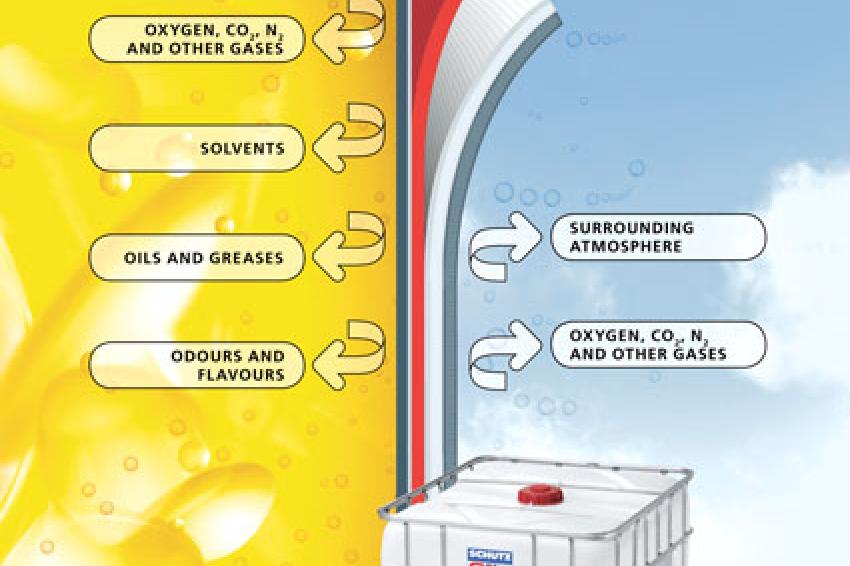On a Par with Stainless Steel Containers
Composite IBCs Open Up New Transport and Storage Prospects
Flexible Alternative - The search for the ideal packaging solution is a traditional feature of industrial activity. Schütz from Selters, Germany, has always adapted its product policies to meet the needs of its customers and markets. When Schütz developed Security Layer Technology, an extrusion blow-molding process that allows three to six different materials to be processed simultaneously, it set new trends in the use of IBCs and plastic drums. The corresponding product innovations are aimed chiefly at substituting stainless steel containers. This applies both to the requirements for transportation and storage of hazardous substances, and to light and UV protection. That's why the packaging products promise multi-flexible applications - for a multitude of industries, from chemical to food.
According to Schütz, the market is looking for more than merely packaging with electrostatic properties; competitive pricing and high quality standards are also important criteria.
The top product among the electrostatically equipped transport containers from Selters is the Ecobulk SX-EX. This IBC with its grid-protected sheet steel jacket fulfils several important criteria at once. It prevents electrostatic charging and protects filling goods perfectly against mechanical and thermal stress, as well as direct sunshine. On top of all this, it provides better protection against the effects of fire.
Because the contents are additionally earthed via the outlet valve, the IBC can be used for liquids that are not conductive. And in conjunction with the tried, trusted and patented SMP barrier - or optionally EVOH oxygen and permeation barrier - the IBC reliably prevents the permeation of filling goods.
The 1,000-litre container is available in this ex-zone certified version with a 225mm filling opening and an outlet valve with a nominal width of 80mm. The Ecobulk SX-EX is unreservedly suitable for filling goods with a flashpoint of less than 61°C. Also, the special HV model comes with a specially designed bottom plate and discharge geometry that makes it ideal for viscous and highly viscous filling products.
The standard IBC produced on the basis of Security Layer Technology and electrostatically equipped in line with Ecobulk MX comes with an array of special design features that make it a unique selling proposition within the industry. The MX-EX IBC is obtainable with an antistatic, translucent inner tank, for instance, and optionally with UV protection (white). According to customer specification, it can also be supplied with a conductive, black inner tank that shields the contents from UV radiation as well as visible light. No additional electrostatic conductivity features are required for the steel cage for example. The valves are individually earthed as necessary for each valve type. The containers are also suitable for transporting goods with a flashpoint of less than 61°C.
EVOH Barrier for Guaranteed Permeation Protection
The six-layer MX-EX-EV model of the IBC offers the added advantage of an EVOH oxygen and permeation barrier. EVOH is an ethylene-vinyl alcohol copolymer and an ideal material for a broad range of applications - especially in the chemical industry with its countless products. Used in Schütz transport packaging, EVOH reliably prevents permeation - acting, for example, as a barrier layer blocking ambient gases, e.g. oxygen/nitrogen injection, flavors and odors and also solvents (e.g. toluenes, xylenes, MEK and benzenes), oils and greases.
Amongst other things, the permeation barrier's virtually zero transmission of O2, CO2 und N2 extends the shelf life of filling products. This is also aided by the optionally available light and UV protection. In containers with an outer PE layer that has been additionally mixed with a white color batch, permeability of visible light is reduced to <20% and that of UV light to < 0.5%. And with inner bottles colored black using the same method, permeation is even as low as < 1% for visible light and < 0.3% for UV light. This ensures that the quality of the filling goods is the same when they come out of the packaging as when they went it.
Composite IBCs vs. Stainless Steel Containers
The latest generation of transport packaging offers users more benefits, which is why Schütz has been able to create new quality segments on the IBC market with a bigger and better product portfolio. Customers can now choose packaging that is even better suited to their individual specifications.
When it comes to product features and property profiles, the new-generation IBCs are practically on a par with conventional stainless steel containers. Their main advantage over stainless steel alternatives is that the initial purchase price of combination IBCs is far lower. Another cost-relevant factor is that, unlike steel models, they require no cleaning since they can be collected and reconditioned free of charge under the Schütz Ticket System.
What's more, even when stainless steel containers are cleaned product residues may remain in the container and contaminate the next batch of goods; this cannot be ruled out. Even the slightest traces of product and silicone residues stuck to the container can render the entire contents of a container unusable. This is a problem that cannot arise with a composite IBC because the inner tank is replaced before each new trip. Residual contamination is therefore impossible and the purity of the filling goods is guaranteed.
These Schütz products compare favorably with their stainless steel alternatives because their production requires less raw material so they weigh much less and consequently cost less to ship.
Added Advantages over Conventional IBCs
The demands on transport packaging vary greatly, depending on the field of application. The special technical properties of Schütz EVOH IBCs also offer a host of advantages over conventional PE packaging.
The extended shelf life of the filling products is a key aspect here. Media (e.g. oxygen) capable of harming the container walls are unable to penetrate from outside. This is good for users because their product maintains its consistency so that it can be properly processed and stored, which in turn means increased flexibility throughout the supply chain. EVOH products even prevent loss of gas and impaired quality in nitrogen-injected filling products.
At the same time, the barrier also includes some important safety aspects. Reduced solvent permeation means that the health risk for handlers is reduced, but that's not all. Thanks to the barrier, the formation of explosive fuel-air mixtures in the outer shell is also prevented and thus a considerable risk is eliminated.
Innovative PE Drums
Schütz has also made an innovative leap forward with PE drums, so that the IBC is no longer the only economically viable packaging alternative to steel drums. The F1-EX tight-head drum now offers the opportunity to cut costs and save effort even where smaller filling volumes are concerned. Thanks to multilayer extrusion, the drum has an outer layer of conductive material (black). The filling goods are earthed via a contact strip. Once it has passed an electrostatic safety test, the drum qualifies for use in ex zones 1 and 2.
The Schütz F1 tight-head drum was developed in close collaboration with Basell and its general performance is outstanding. It is made of the new multimodal polyethylene Histif 5431Z, which is produced using Basell's innovative Advanced Cascade Process technology.
This drum's material profile makes it superior in every respect to conventional products. All in all, it impresses with great cold-temperature impact strength, greatly improved stacking-pressure resistance and also resistance to stress cracking. Schütz has successfully conducted cold drop tests of up to three meters, a sensational height for drums. Last but not least, the product facilitates complete discharge of filling goods (<100ml) via both openings in conformity with VPA4.
Thanks to these properties and the potential applications they entail, PE drums have also caught up and are now a viable alternative to corresponding steel products.
On balance, the physical and chemical properties of the new IBC and drum generations from Schütz are not alone responsible for the many advantages over alternatives made of steel, but also additional aspects, like quality, safety, green considerations, health, improved handling and costs, too. Most particularly, the all-round positive effects on the entire supply chain of the new packaging models are further reasons for their innovative character and potential application in practically every industry segment.














